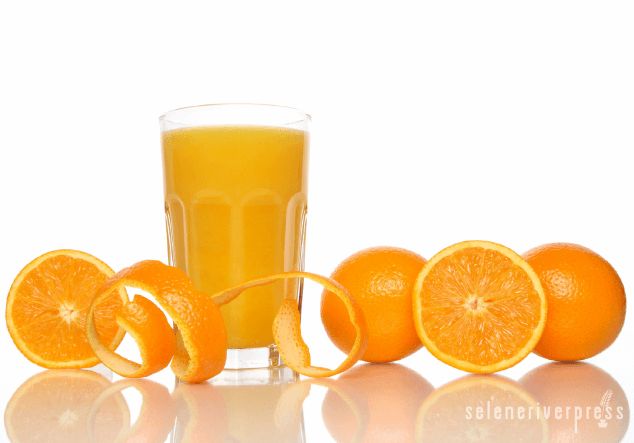I am deeply interested not only in your health individually but in the efficiency and welfare of your families. It is particularly important in these times of industrial and financial stress that children shall not suffer defects, which may mark and handicap them for their entire life.
—Dr. Weston A. Price
So wrote the author of Nutrition and Physical Degeneration, the classic work on the relation of diet to disease, to his nieces and nephews in the year 1934. He signed the letter, “Lovingly, Uncle Weston.”
Dr. Price stated that cooking destroys vitamin C in many fruits, and he therefore advocated that they be eaten raw. Fermentation of fruits, however, makes them a super raw food!
One of the best tasting fermented beverages is orangina, and I’ve included the recipe below. You’ll also find a recipe for one of our favorite health giving fruits—lemons—plus tips for more seasoned ferment makers and suggestions for adding some zip to lovely super raw fermented foods.
Along the way in my super raw food adventures, I’ve amassed a small library’s worth of recipes for dishes that can be made with fermented foods. My newest addition, which I highly recommend, is Phyllis Quinn’s Udderly Cultured. It’s loaded with the type of recipes that Sally Fallon Morrell would call super raw.
Here are some other super raw fermented favorites I’ve collected over the years:
- Cortido. You can make this with pineapple vinegar or the flavors of Mexico. Pineapple vinegar consists of fermented pineapple skins and cores. Mexican flavors include hot chiles, cumin, oregano, onion, or garlic. I always make this dish with a mix of cabbage and carrots.
- Garlic-Onion Kraut. You can use thinly sliced onions and either sliced or whole garlic. Though whole garlic cloves take months and months to get soft and fermented (as opposed to harsh and raw tasting), they add flavor to the kraut from the start.
- Apple-Cranberry Kraut. This calls for grated apple and sliced or halved cranberries. You can also try it with a mix of green and purple cabbage for pink kraut.
- Kimchi. Simply add chili powder, garlic, ginger, and onion to any variety of vegetables to make kimchi. Try it with Napa cabbage or daikon radishes.
- Green Beans. Prepare fermented green beans with garlic and onions, and maybe some chili flakes and dill seed.
- Green Tomatoes. These are interesting plain, with a little onion or garlic, and with or without mustard seeds or chili flakes.
- Summer Vegetable Relish. Make this tasty relish with green tomato, cucumber, canned or fresh corn, red bell pepper, onion, garlic with dill seed, and/or mustard seed, and/or chili flakes.
- Spicy Carrot Pickles. Prepare with sliced carrots, onions with garlic and jalapenos, or other hot chili peppers.
- Garlic. I make it plain, using just garlic cloves and salt—it takes forever, but it’s awesome in a salad dressing or a Bloody Mary.
- Turnips. Try these sliced with carrots or grated into cabbage.
And here is a recipe for ferments you may not have considered:
Fermented Orange Juice (Orangina)
—Adapted from oh lardy
Ingredients
2½–3 cups fresh squeezed orange juice
2 tablespoons whey (see instructions in Cook Your Way to Wellness)
1 cup filtered water
Sea salt
Instructions
- Pour orange juice into a 1-quart Mason jar. Add whey.
- Fill with approximately 1 cup room temperature filtered water, leaving 1 inch or so for headspace.
- Cover tightly with a white plastic lid and give a gentle shake to mix. Leave at room temperature for 48 hours.
- Refrigerate for approximately 2 weeks. Use a straw to test if it’s carbonated enough. Gases build up during fermentation, so open carefully!
Photo from iStock/AnikaSalsera




2 weeks is a long time to wait. Any way to speed up the fermentation? Milk and kefir grains?
You can wave your magic wand over them and make instant ferments! Just kidding, Brad. You have to think beer and wine. It can take years for some ferment processes. The author of the post, Maria Atwood, said to tell you: The fact is, two weeks is nothing! I have to ferment my beet kvass for 4 weeks to get it really carbonated. Many people get discouraged but that’s because they don’t understand Mother nature which as we all know is not an instant process, it takes time for the sugars to be eaten up and the carbonation and fermentation to be in the state that is really called fermented so it can genuinely have the probiotic effect we want from fermentation. Kefir takes less time and so it depends on the particular ferment. Sauerkraut for instance also does not take as long but it does seem that beverages to take longer. Garlic, takes months! -Maria Atwood
You might want to get a copy of “The Art of Fermentation” for a broad understanding of the fermentation process. Once you get the process going, you’ll always have some on hand for consuming while more is brewing in the basement.